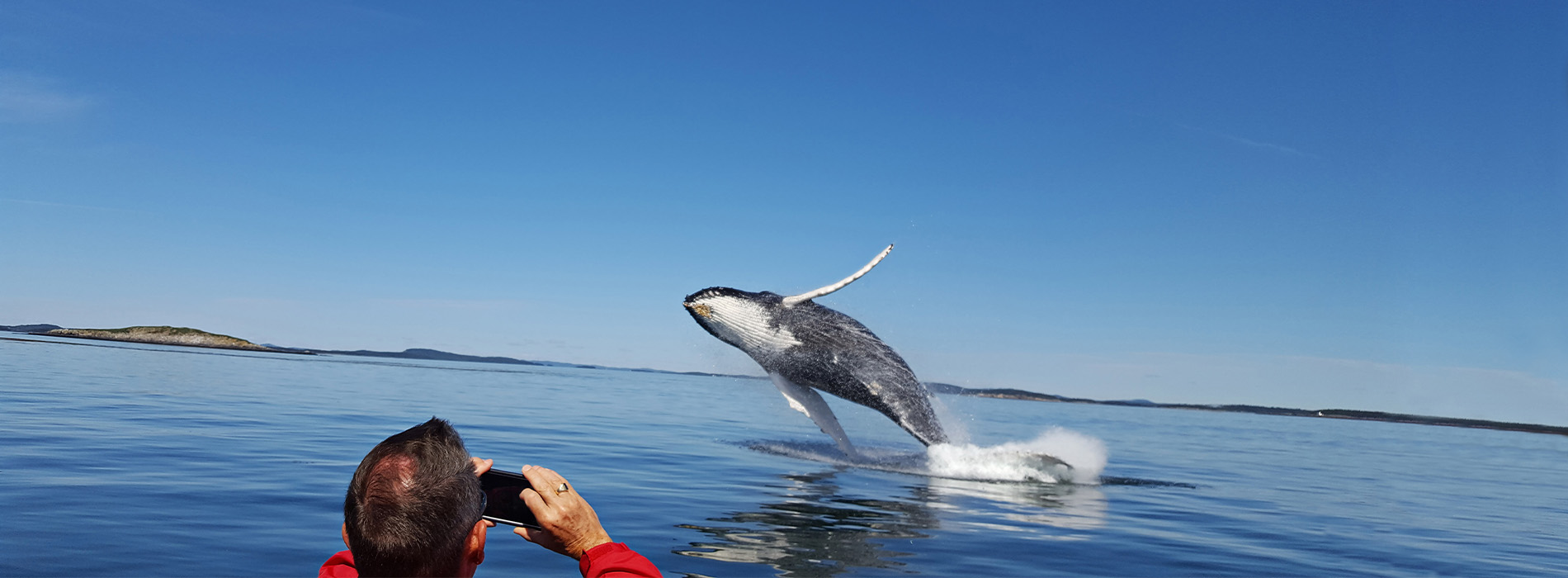Travelling New Brunswick’s Bay of Fundy, Tracey Davies finds breaching whales, grand canyons and the world’s highest tides
Click here to download and save as a PDF
“What? Where? I can’t see it!” Yet again I miss the slippery black fin arcing out of the waters while the rest of boat gasps in awe. Typical. Only I could come to the biggest whale party of the season and have my back turned while minkes, finbacks and porpoises do the conga around the boat.
Stretching for 170 miles between Canada’s Maritime provinces of Nova Scotia and New Brunswick, the Bay of Fundy funnels the St Lawrence River to cause the world’s most extreme tides.
And it’s these feisty waters that suck up all the juicy, delicious plankton to attract minke, pilot and even blue whales to the nutrient-rich Passamaquoddy Bay, an inlet of the Bay of Fundy.
Twice a day, a ridiculous 160 billion tons of seawater – twice as much as the flow from all the rivers in the world – rushes through the bay, causing 15-metre-high tides.
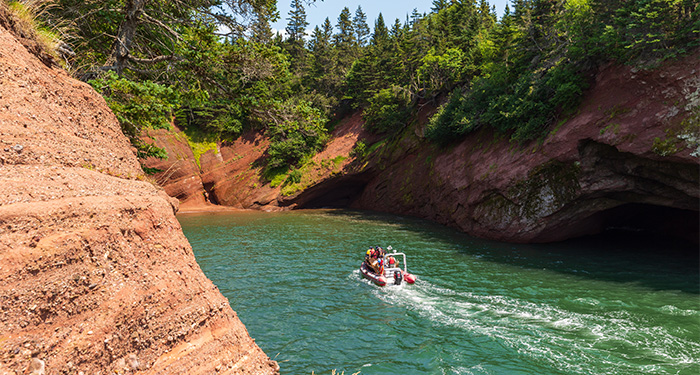
Saint John brews
I’m racing those tides on a week-long road trip along the Fundy Coast with Tourism New Brunswick, starting in the seaport of Saint John, a 90-minute flight from Montreal.
Far from being a fusty old town, Canada’s oldest city has wide streets lined with grand redbrick buildings, microbrew pubs and farm-to-fork bistros, and has a cool young vibe, not least thanks to Area 506, a new Boxpark-style container village that even has a cannabis shop (don’t worry, it’s legal here).
Of course, the best way to see any new city is with a local tour, preferably one with plenty of beer involved like Uncorked NB. There are 60 breweries in New Brunswick alone, including Moosehead, the oldest independent brewery in Canada.
Canada’s oldest city has wide streets lined with grand redbrick buildings
I do my best to taste as many as I can on a drinking tour of the city. Starting from Saint John City Market, it explores New Brunswick’s history and brewing heritage through its local boozers.
To soak up the 160 billion tons of beer it feels like I’ve sampled, a plate of Digby bacon maple scallops followed by shaved beef rib and mash at Saint John Ale House on the waterfront do their best to sober me up.
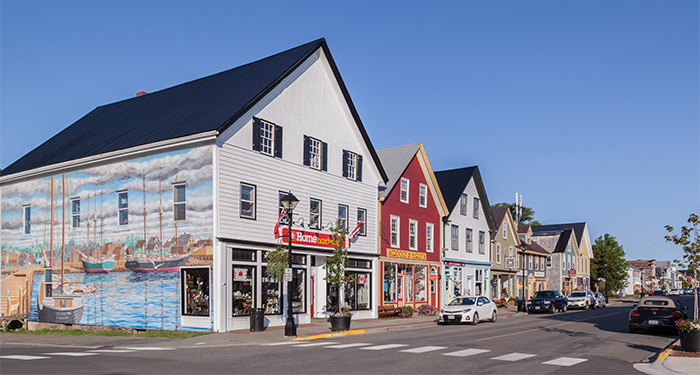
The Canadian Cape Cod
After breakfast, it’s an easy hour’s drive over to St Andrews-by-the-Sea, a candy-hued seaside resort on Passamaquoddy Bay.
Named the Best Destination in Canada by USA Today, the charming resort town is only a mile or so as the crow flies from the US state of Maine and has a distinct Cape Cod vibe – minus the clamouring crowds.
The main Water Street is lined with New England-style clapboard houses and seafood diners such as the Red Herring, where I easily pass as a Canadian by ordering lobster poutine: fries topped with lobster, cheese curds and hollandaise sauce.
Fundy Bay life is ruled by the tides. After my whale-watching cruise, it’s a mad dash across to Minister’s Island, the former estate of railway magnate Sir William Van Horne, before the tide comes in and I’m stranded.
These extraordinary themed gardens feature ancient Acadian forest trails
It happens. Luckily, I make it back to the Algonquin Resort, a grand Tudor Revival pile and the grande dame of St Andrews. It’s one of two hotels rumoured to have inspired author Stephen King – who lives across the water in Maine – to write The Shining.
It’s also moments from Kingsbrae Garden, one of the most beautiful gardens in Canada. Sprawling across 27 acres, these extraordinary themed gardens feature ancient Acadian forest trails, a sculpture park and even roaming alpacas, and are perfect to explore for a morning.
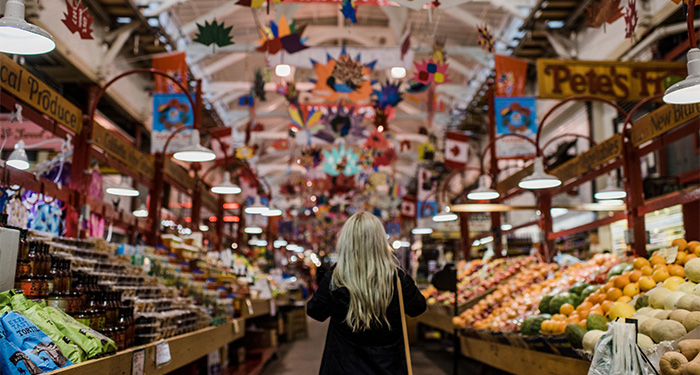
On the trail
Next up, it’s an easy drive north to the start of Canada’s newest scenic byway, the Fundy Trail Parkway. I stop off for some ”world-famous” seafood chowder at The Cliffs before a peek into the sea caves at St Martins.
Carved by tides over millennia, the sandstone caves are showered in shells, sea glass and fossils at low tide. Then, six hours later, the water rises to up to 12 metres and the caves disappear.
The Fundy Trail Parkway owes its entire existence to one Dr Mitchell Franklin, a New Brunswick businessman and philanthropist who died in 2006. Mitchell adored the Bay of Fundy and it was his vision to connect the Fundy National Park to St Martins with a scenic parkway to showcase it to the world.
Carved by tides over millennia, the sandstone caves are showered in shells
Over the past 60 years, it was his determination, faith in the idea and political connections that made it actually happen. Next year, it will be 25 years since the first 10k of the parkway opened, transforming tourism in this tiny corner of Canada.
As I approach the freshly tarmacked route, it immediately reminds me of Australia’s Great Ocean Road, considered one of the world’s most scenic coastal drives.
The new parkway largely follows the Fundy Footpath, a long-distance hiking trail along what’s considered to be the last undeveloped area of coastal wilderness between Labrador and Florida.

Scenic stops
Rivalling the views of California’s Highway 1 and the Hana Highway in Hawaii, the 19-mile-long parkway throws out some breathtaking sights. Luckily, there are 21 scenic overlooks to stop at along the trail, each one smacking you around the chops with its staggering views. And considering it’s high season, I’m sharing them with very few eyes indeed.
One place I was itching to see is Walton Glen Gorge, a 500-million year old canyon known as the Grand Canyon of New Brunswick. Until recently, only the fittest could see it via an eight-hour hike, but this year, a new 0.6-mile shortcut means even this lazy bones gets to witness its magnificent views down to the bay.
The giant ethereal rocks look almost like Easter Island statues
My final stop is Hopewell Rocks. Again, you have to know your tides. At high tide, I take a kayaking tour that weaves around the flowerpot-shaped sea stacks eroded by the twice-daily tides.
The next morning, I return to Hopewell Rocks at low tide for a spot of beachcombing along the seabed, which is an entirely different experience from yesterday.
The giant ethereal rocks look almost like Easter Island statues as they rise up from the ocean floor. In the distance, as the seas come in, I spot silver-bellied sandpipers dancing over the rising water – a serene end to a high-octane tour.
Where to stay
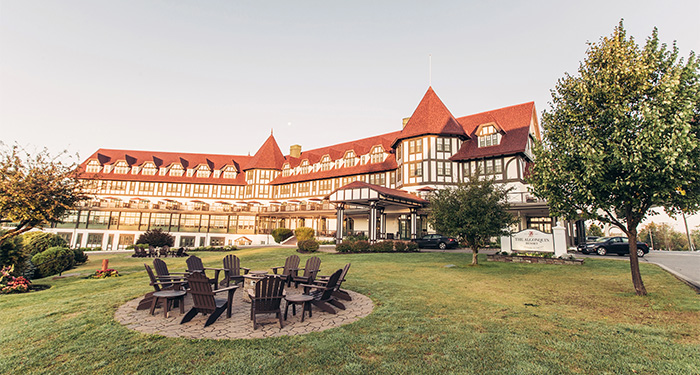
The Algonquin Resort
With 233 rooms, a full spa, indoor and outdoor pools, and a 72-par golf course, the grande dame of St Andrews-by-the-Sea is pretty special. Rooms from £165.
algonquinresort.com
Hilton Saint John
Overlooking the harbour, this downtown Hilton has almost 200 rooms, an indoor seawater pool and a bistro. Rooms from £155.
hilton.com
Delta Beauséjour
Steps from the tidal bore viewing point on the Petitcodiac River, the smart Delta Beauséjour in Downtown Moncton features a spa, an indoor pool and a brasserie. Rooms from £130.
marriott.com
Ask the expert

Alison Aiton, director of business and major events, Tourism New Brunswick
“There are two main selling points for a road trip along the Fundy Trail Parkway. It’s one of the last stretches of undeveloped coastline between Labrador and Florida. It also incorporates two Unesco areas: the Fundy Biosphere Reserve and Stonehammer Global Geopark.
Don’t drive too quickly along the Fundy Trail. A big part of the experience is the way the road has been built to reveal the amazing vistas. Every twist and turn reveals another amazing coastal view.”
Book it
First Class Holidays’ eight‑day Discover the Bay of Fundy self-drive trip costs from £1,649 per person, including accommodation, car hire and return flights from Heathrow with Air Canada, based on a departure on May 15, 2023.
Incentive: Agents booking Canada trips with First Class Holidays will be in with a chance to win flights to Canada.
fcholidays.com
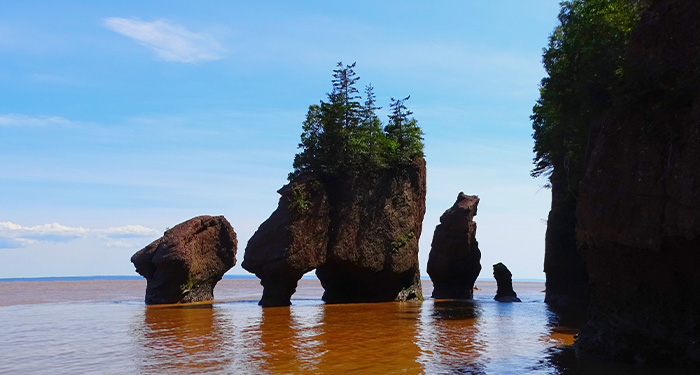
PICTURES: New Brunswick Tourism; Nick Hawkins; Shutterstock/Ken Morris, GIBAN
Read more
How to sell trips to Atlantic Canada – tips from the experts
Canada: New flights bring Quebec’s jaw-dropping nature that little bit closer
Why Indigenous tourism is so important in Canada

